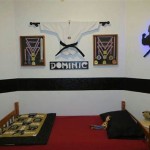Decorating A Dining Room Wall: A Guide to Enhancing Your Space
The dining room stands as a central hub within the home, fostering connection and shared experiences through meals and gatherings. It is a space where memories are made, and conversations flow. The ambiance of a dining room significantly contributes to the overall dining experience. Decorating a dining room wall provides a significant opportunity to elevate this ambiance, creating a setting that is both aesthetically pleasing and conducive to enjoyable gatherings. A carefully chosen wall decoration can transform a bland room into a captivating and inviting space, reflecting the homeowner's personal style and enhancing the room's overall appeal.
Effective dining room wall decoration requires careful consideration of several factors, including the room's size, existing decor, and the desired aesthetic. A rushed or poorly planned approach can result in a space that feels cluttered, unbalanced, or simply uninspired. Before committing to a particular design, it is prudent to evaluate the room's existing color palette, furniture style, and lighting scheme. This assessment will help determine the most appropriate style and scale of wall decorations, ensuring a cohesive and harmonious result.
This article will explore various strategies for decorating a dining room wall, offering practical advice and insightful considerations to guide the reader in creating a visually appealing and inviting dining space. The aim is to provide a comprehensive overview of techniques, styles, and elements that can contribute to a successful and personalized dining room design.
Selecting the Right Artwork
Artwork represents a cornerstone of effective dining room wall decoration. The selection of artwork should align with the room's existing style and the homeowner's personal tastes. The size and scale of the artwork are crucial considerations. A small piece of art can become lost on a large wall, while an overly large piece can overwhelm a smaller space. As a general rule, the artwork should be proportional to the wall and the surrounding furniture. Before hanging anything, consider mocking up the display using paper cutouts to visualize the arrangement and scale on the wall. This can help prevent making unnecessary holes and save time in the long run.
The subject matter of the artwork can also influence the dining room's ambiance. Landscape paintings or nature-inspired prints can create a calming and serene atmosphere, while abstract art can inject a sense of modernity and sophistication. Portraits or figure studies can add a touch of elegance and personality to the space. It is important to consider the color palette of the artwork and ensure that it complements the existing colors in the room. Neutral colors and muted tones can create a subtle and understated look, while bolder colors can add vibrancy and energy.
Framing plays a significant role in enhancing the overall impact of artwork. Choosing the right frame can elevate the artwork and integrate it seamlessly into the room's decor. A simple, minimalist frame can complement modern artwork, while a more ornate frame can enhance traditional or classic pieces. Consider the material and finish of the frame, ensuring that it coordinates with the other materials and finishes in the room. Experimenting with different framing styles can significantly transform the appearance of the artwork.
Hanging artwork at the correct height is essential for creating a visually balanced and aesthetically pleasing display. A general guideline is to hang the artwork so that the center of the piece is approximately 57 to 60 inches from the floor. This height is considered eye level for most people. However, it is important to adjust the height based on the specific dimensions of the wall and the surrounding furniture. If hanging artwork above a dining table or other furniture, ensure that there is sufficient space between the bottom of the artwork and the top of the furniture to avoid a cluttered or cramped look.
Incorporating Mirrors and Reflective Surfaces
Mirrors represent versatile tools for enhancing the visual appeal of a dining room and creating the illusion of increased space. Strategic placement of mirrors can significantly amplify natural light, making the room feel brighter and more open. Mirrors can also reflect existing decorative elements, such as artwork or lighting fixtures, creating a more layered and dynamic aesthetic. The size and shape of the mirror should be carefully considered, taking into account the dimensions of the wall and the desired effect.
A large, statement mirror can serve as a focal point in the dining room, drawing the eye and creating a sense of drama. Alternatively, a collection of smaller mirrors can be arranged to create a gallery wall effect, adding visual interest and texture to the space. The style of the mirror should complement the overall decor of the room. A sleek, modern mirror can enhance a contemporary dining room, while an antique mirror with an ornate frame can add character to a traditional space.
When placing mirrors, it is important to consider what they will reflect. Avoid placing mirrors in locations where they will reflect clutter or unsightly views. Instead, position them to reflect attractive features of the room, such as a beautiful chandelier, artwork, or a scenic view through a window. The reflection should enhance the room's aesthetics, not detract from it.
Mirrored wall panels can create a dramatic and luxurious effect in the dining room. These panels can be installed on an entire wall or used as accents to add depth and dimension. Mirrored panels are particularly effective in smaller dining rooms, as they can create the illusion of a larger space. However, it is important to use mirrored panels sparingly, as too much reflection can create a disorienting or overwhelming effect.
Beyond simple glass mirrors, consider using other reflective surfaces. Metallic accents, such as gold or silver leaf, can add a touch of glamour to the dining room wall. Decorative trays or platters with a metallic finish can also be hung on the wall to create a unique and eye-catching display. The key is to incorporate reflective elements thoughtfully and strategically, enhancing the room's overall ambiance without creating a sense of clutter or distraction.
Creating a Gallery Wall
A gallery wall represents an excellent way to personalize a dining room and showcase a collection of artwork, photographs, or other decorative items. A well-curated gallery wall can add character, visual interest, and a sense of personality to the space. Planning a gallery wall requires careful consideration of several factors, including the size and shape of the wall, the style and subject matter of the artwork, and the desired overall aesthetic.
Before starting, it is beneficial to lay out the arrangement on the floor. This allows for experimentation with different layouts and spacing without committing to any specific configuration. Using paper cutouts that are the same size as the artwork can further refine the arrangement and ensure a balanced and visually appealing display. Taking the time to plan the gallery wall beforehand can save time and prevent making unnecessary holes in the wall.
The artwork selected for a gallery wall should ideally share a common theme or aesthetic, such as a particular color palette, subject matter, or style of framing. This creates a sense of cohesion and harmony, preventing the gallery wall from appearing disjointed or haphazard. However, a successful gallery wall can also incorporate diverse elements, as long as they are carefully curated and arranged to create a visually pleasing composition.
Mixing different sizes and shapes of artwork can add visual interest to a gallery wall. Incorporating both framed and unframed pieces can also create a more dynamic and textured display. Consider including other decorative items, such as mirrors, sconces, or small shelves, to add depth and dimension to the gallery wall. The key is to create a balanced and visually appealing composition that reflects the homeowner's personal style.
The spacing between the artwork is an important consideration. Consistent spacing creates a clean and organized look, while tighter spacing can create a more dense and impactful display. A general rule of thumb is to leave approximately two to four inches of space between each piece of artwork. However, the specific spacing may need to be adjusted depending on the size and style of the artwork.
Hanging the artwork requires precision and attention to detail. Using a level is essential for ensuring that the artwork is hung straight. Consider using picture-hanging strips instead of nails or screws, as these strips are less damaging to the wall and allow for easier repositioning of the artwork. If using nails or screws, be sure to use the appropriate type and size for the wall material. Finally, stand back and evaluate the overall composition of the gallery wall, making any necessary adjustments to ensure a balanced and visually appealing display.

23 Dining Room Wall Décor Ideas To Liven Up Your Space Modern Farmhouse Grey Decor

Thrifty And Chic Diy Projects Home Decor
:strip_icc()/127107347_378909933559802_5209338986625741338_n-d8e04eccf7274b2b91e5b75ec9ca40ef.jpg?strip=all)
29 Dining Room Wall Décor Ideas

Dining Room Wall Decor Ideas For Your Home Design Cafe

54 Simple Dining Room Wall Decor Ideas Displate Blog

Cozy Dining Room Decorating Ideas Sanctuary Home Decor

20 Ways To Dress Up Dining Room Walls Wall Decor

54 Simple Dining Room Wall Decor Ideas Displate Blog

12 Stunning Modern Dining Room Wall Decor Ideas Design Cafe
:max_bytes(150000):strip_icc()/art4-445991107c1841ccb4f3a266e6793183.jpg?strip=all)
46 Dining Room Wall Art Ideas For Elevated Entertaining
Related Posts







